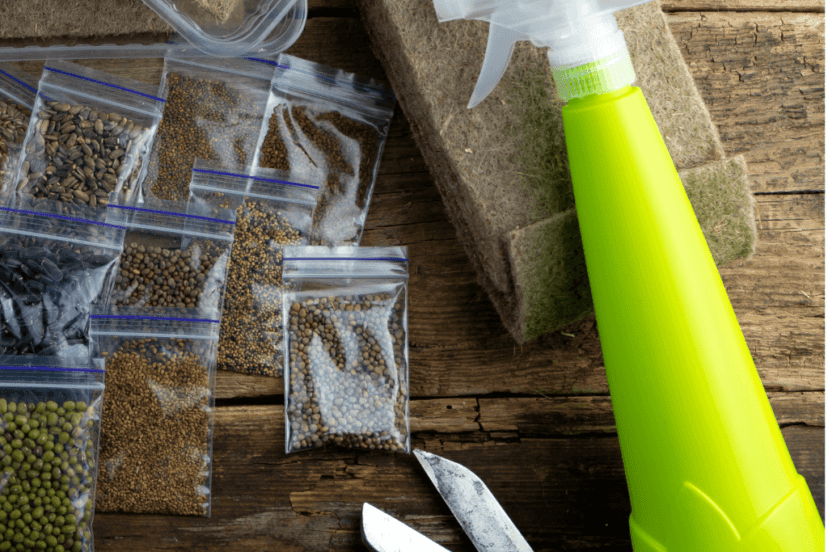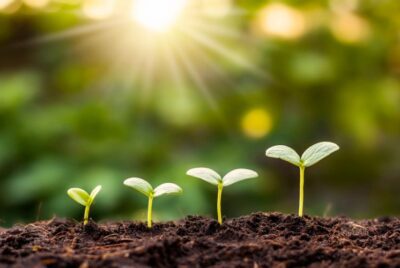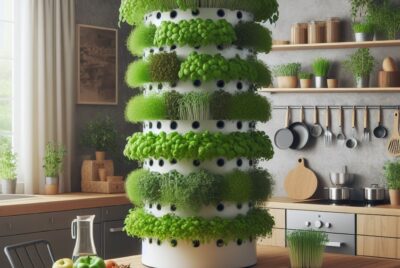Growing Media for Microgreens: Cultivating Healthy and Vibrant Greens
I understand the importance of choosing the right growing media for successful cultivation. Microgreens, with their delicate textures, vibrant colors, and concentrated flavors, have gained immense popularity among health-conscious individuals, chefs, and food enthusiasts alike. In this article, I will guide you through the world of growing media for microgreens, offering valuable suggestions and reasons to support my recommendations.
Introduction to Microgreens
Microgreens, often referred to as “vegetable confetti,” are the edible young seedlings of various vegetables and herbs. These tiny greens are harvested just after the first set of true leaves appear, typically within 7 to 21 days of germination. Despite their small size, microgreens are packed with intense flavors and an impressive nutritional profile. Studies have shown that microgreens can contain up to 40 times more vitamins and minerals compared to their mature counterparts.
Importance of Growing Media
The choice of growing media significantly influences the growth and development of microgreens. Growing media, also known as substrates or potting mixes, provide physical support, water retention, and nutrient availability to the plant roots. When selecting a growing media for your microgreens, consider the following factors:
Role of Growing Media in Microgreen Cultivation
The growing media acts as a reservoir for water and nutrients, ensuring a consistent supply to the developing seedlings. Additionally, it provides a stable foundation for the roots, allowing for optimal anchorage and nutrient uptake.
Factors to Consider When Choosing a Growing Media
When selecting a growing media for your microgreens, several factors should be taken into consideration. These include:
- Water retention: A good growing media should have the ability to retain moisture, providing a consistent water supply to the microgreens without becoming waterlogged.
- Nutrient availability: The growing media should be capable of holding and releasing nutrients as needed by the microgreens, promoting healthy growth and development.
- pH balance: Maintaining the appropriate pH level is crucial for optimal nutrient uptake. The growing media should have a pH range suitable for the specific microgreen varieties you intend to grow.
- Sterility: Ensuring the growing media is sterile helps prevent the growth of harmful pathogens and reduces the risk of plant diseases.
Now that we understand the importance of growing media and the factors to consider, let’s explore the different types of growing media suitable for microgreens.
Soil-Based Growing Media

Advantages and Disadvantages of Using Soil
Soil is a traditional and widely used growing media for microgreens. It provides excellent water retention, nutrient availability, and a stable base for the seedlings. Additionally, soil-based media often contain natural microorganisms that can benefit the overall health of the microgreens. However, there are a few considerations to keep in mind:
- Contamination risk: Soil can potentially harbor pathogens or unwanted weed seeds, increasing the risk of plant diseases or competition with undesirable plants.
- Nutrient variability: The nutrient content of soil can vary, requiring additional amendments to ensure an optimal nutrient balance for microgreen growth.
Recommended Soil Types for Microgreens
When opting for soil-based growing media, it’s essential to choose the right soil type. Here are a few recommended soil types for microgreens:
- Potting soil: A general-purpose potting soil is a popular choice for microgreens. Look for a well-draining mix with good water retention and balanced nutrients.
- Coconut coir-based soil: Soil mixes that contain coconut coir provide excellent water retention and aeration, promoting healthy root development.
- Vermiculite-enriched soil: Vermiculite, a mineral known for its water-holding capacity, can enhance the moisture retention of soil-based growing media.
While soil-based growing media have their advantages, there are alternative options that offer specific benefits. Let’s explore soilless growing media next.
Soilless Growing Media

Benefits of Soilless Growing Media
Soilless growing media, as the name suggests, do not contain traditional soil. Instead, they are designed to provide an optimal environment for root growth and nutrient absorption. Soilless growing media offer several advantages:
- Reduced contamination risk: Soilless media are typically sterilized, minimizing the chances of contamination and plant diseases.
- Consistent nutrient levels: These media can be precisely formulated to provide a consistent and balanced nutrient supply to the microgreens.
- Improved drainage: Soilless media promote excellent drainage, preventing waterlogging and reducing the risk of root diseases.
Different Options Available
There are several soilless growing media options to choose from when cultivating microgreens. Let’s explore a few popular choices:
- Coco coir: Made from the fibrous husks of coconuts, coco coir is an excellent alternative to soil. It retains moisture well, provides good aeration, and is environmentally sustainable.
- Peat moss: Peat moss is another common soilless medium. It offers good water retention, promotes root development, and is often mixed with other ingredients to create balanced growing media.
- Vermiculite: While primarily used as an additive in soil-based media, vermiculite can also be used as a standalone medium. It retains moisture well and provides excellent aeration, making it suitable for hydroponic systems.
- Perlite: Perlite is a lightweight volcanic rock that is often used as a component in soilless growing media. It improves drainage, promotes root development, and helps prevent compaction.
Each soilless growing medium has its unique characteristics, so it’s essential to consider your specific needs and preferences when choosing the right one for your microgreens.
Hydroponic Growing Media

Explanation of Hydroponic Systems
Hydroponics is a soilless cultivation method that involves growing plants in a nutrient-rich water solution. In hydroponic systems, the growing media serves as a support structure for the plants while allowing their roots to come into direct contact with the nutrient solution. Some popular hydroponic systems for microgreens include nutrient film technique (NFT), deep water culture (DWC), and vertical towers.
Advantages and Considerations for Hydroponic Growing Media
Hydroponic growing media offer several advantages for microgreen cultivation:
- Enhanced nutrient availability: Hydroponic systems deliver nutrients directly to the plant roots, ensuring efficient uptake and utilization.
- Water efficiency: Hydroponics uses significantly less water compared to traditional soil-based cultivation methods.
- Faster growth: The controlled environment of hydroponics can lead to accelerated growth rates and higher yields.
When selecting a hydroponic growing media, consider factors such as water retention, root support, and pH stability. Some common options include expanded clay pellets, rockwool, and coco coir.
Vermiculite as a Growing Medium

Overview of Vermiculite
Vermiculite is a natural mineral that expands when heated, creating lightweight and moisture-absorbent flakes. It has been used as a growing medium in horticulture for many years.
Benefits and Drawbacks of Using Vermiculite for Microgreens
Vermiculite offers several advantages when used as a growing medium for microgreens:
- Excellent moisture retention: Vermiculite has a high water-holding capacity, ensuring a steady supply of moisture to the microgreens.
- Enhanced aeration: The porous structure of vermiculite allows for proper air circulation, preventing root suffocation.
- Nutrient retention: Vermiculite can hold and release nutrients, promoting healthy growth and development.
However, there are a few drawbacks to consider:
- Limited nutrient content: Vermiculite is relatively low in nutrients, so it may require supplemental fertilization for optimal growth.
- pH adjustment: Vermiculite tends to have a higher pH, so careful monitoring and adjustments may be necessary to maintain the appropriate pH level for microgreens.
Despite these considerations, vermiculite can be a viable option, particularly when combined with other growing media or as part of hydroponic systems.
Coconut Coir as a Growing Medium

Introduction to Coconut Coir
Coconut coir is derived from the fibrous husks of coconuts. It is an increasingly popular growing medium due to its sustainability, excellent water retention, and neutral pH.
Advantages and Considerations for Using Coconut Coir
Coconut coir offers several benefits for microgreen cultivation:
- Water retention: Coconut coir retains water well, ensuring a consistent supply of moisture to the microgreens while maintaining proper drainage.
- pH neutrality: Coconut coir has a near-neutral pH, providing an optimal environment for nutrient uptake.
- Sustainability: Coconut coir is a renewable resource and an eco-friendly alternative to peat moss.
When using coconut coir, it’s important to consider its salt content. Rinse the coir thoroughly before use to remove excess salts and ensure optimal growing conditions for microgreens.
While coconut coir is an excellent growing medium, there are a few considerations to keep in mind:
- Nutrient supplementation: Coconut coir is relatively low in nutrients, so additional fertilization may be necessary to provide essential elements for microgreen growth.
- Compactability: Coconut coir can become compacted over time, affecting drainage and root development. Regular fluffing or mixing can help prevent this issue.
Overall, coconut coir is a sustainable and effective growing medium that promotes healthy and vigorous microgreen growth.
Peat Moss as a Growing Medium

Explanation of Peat Moss
Peat moss is a natural organic material derived from partially decomposed sphagnum moss. It has been widely used as a growing medium in horticulture.
Pros and Cons of Using Peat Moss for Microgreens
Peat moss offers several benefits as a growing medium for microgreens:
- Excellent water retention: Peat moss retains water well, providing consistent moisture to the microgreens.
- Good aeration: Its fibrous structure allows for proper airflow and oxygenation of the root zone.
- Acidic pH: Peat moss tends to have a slightly acidic pH, which is favorable for certain microgreen varieties.
However, there are a few drawbacks to consider:
- Environmental concerns: Peat moss harvesting raises concerns about habitat destruction and carbon emissions. Opting for sustainable alternatives like coconut coir or vermiculite is more environmentally friendly.
- Nutrient content: Peat moss has low nutrient levels, so supplemental fertilization is often necessary for healthy microgreen growth.
- pH acidity: While the acidic pH can benefit some microgreen varieties, it may require adjustments for others that prefer a more neutral or alkaline environment.
Considering the environmental impact and nutrient limitations, it is worth exploring alternative growing media for sustainable microgreen cultivation.
Importance of Moisture Retention
How Moisture Affects Microgreen Growth
Proper moisture management is vital for successful microgreen cultivation. Adequate moisture levels ensure germination, root development, and nutrient uptake.
Choosing a Growing Media with Good Moisture Retention
When selecting a growing medium, opt for one with excellent moisture retention properties. This ensures a constant supply of water to the microgreens, preventing drought stress or waterlogging.
Soilless media like coco coir, vermiculite, and rockwool are known for their moisture retention capabilities. Additionally, incorporating water-holding amendments like organic compost or hydrogels into soil-based media can improve moisture retention.
Proper watering techniques, such as misting or bottom watering, also play a crucial role in maintaining optimal moisture levels for microgreens.
Nutrient Considerations
Role of Nutrients in Microgreen Cultivation
Microgreens have high nutrient demands during their rapid growth phase. Providing adequate nutrients is essential for achieving healthy and vibrant greens.
Ensuring Proper Nutrient Availability in the Growing Media
When selecting a growing media, consider its nutrient-holding capacity and ability to release nutrients as needed by the microgreens. Soilless media can be tailored with specific nutrient formulations, ensuring a balanced supply throughout the growth cycle.
For soil-based media, incorporating organic compost, worm castings, or slow-release fertilizers can enhance nutrient availability. Regular monitoring of nutrient levels and appropriate fertilization are necessary to meet the microgreens’ nutritional requirements.
It’s important to strike a balance between providing sufficient nutrients for growth while avoiding excessive fertilization, which can lead to nutrient imbalances or toxicity.
Factors Affecting pH Levels
pH Requirements for Microgreens
Maintaining the appropriate pH level is crucial for microgreen growth and nutrient uptake. Different microgreen varieties have varying pH preferences, so it’s important to consider this when selecting a growing medium.
Factors Influencing pH Levels in Growing Media
Several factors can affect the pH levels of the growing media:
- The composition of the media itself: Some growing media, like peat moss, tend to have naturally acidic pH levels. Others, such as coco coir, have a more neutral pH. Understanding the pH characteristics of the chosen medium is important for maintaining the desired pH range.
- Water quality: The pH of the water used for irrigation can impact the overall pH of the growing medium. If the water is too acidic or alkaline, it can shift the pH of the medium accordingly.
- Fertilizer selection: Fertilizers can have acidic or alkaline properties, depending on their composition. When using fertilizers, it’s important to consider their impact on the pH of the growing medium and make appropriate adjustments.
Monitoring and Adjusting pH Levels

Regular pH monitoring is essential to ensure the optimal pH range for microgreens. A pH testing kit or a digital pH meter can be used to measure the pH of the growing medium.
If the pH deviates from the desired range, adjustments can be made by using pH modifiers. For instance, adding dolomite lime can raise the pH in acidic media, while sulfur or peat moss can lower the pH in alkaline media.
Maintaining the proper pH range is crucial for nutrient availability and optimal growth of microgreens.
Conclusion
Choosing the right growing media for microgreens is a critical decision that can significantly impact their growth and overall success. Soil-based media, such as potting soil or coconut coir-based soil, offer excellent water retention and nutrient availability. Soilless media like coco coir, vermiculite, and peat moss provide a sterile and controlled environment for microgreen cultivation. Hydroponic systems, utilizing media like expanded clay pellets or rockwool, offer unique advantages such as enhanced nutrient uptake and water efficiency.
Consider factors such as water retention, nutrient availability, pH balance, and sterility when selecting a growing medium. Each type of medium has its own advantages and considerations, so it’s important to choose one that aligns with your specific needs and preferences.
Remember to maintain proper moisture levels, provide adequate nutrients, and monitor and adjust the pH levels as needed. With the right growing media and proper care, you can enjoy bountiful and healthy microgreens right from your own home.
FAQs (Frequently Asked Questions)
1. Can I reuse the growing media for multiple cycles of microgreen cultivation?
Yes, soil-based media can be reused, but it’s important to sterilize or amend the media between cycles to minimize the risk of diseases. Soilless media like coco coir or vermiculite can also be reused, but it’s recommended to replace or refresh the media periodically for optimal results.
2. Can I mix different types of growing media together?
Yes, you can mix different growing media together to create a blend that combines their individual benefits. For example, combining coco coir and vermiculite can provide enhanced water retention and nutrient availability.
3. How often should I water my microgreens when using different growing media?
The frequency of watering depends on the specific growing media, environmental conditions, and the moisture needs of the microgreens. It’s best to monitor the moisture levels in the media and water when it begins to dry out, avoiding both overwatering and underwatering.
4. Do I need to adjust the pH of the growing media for every microgreen variety?
Not necessarily. While some microgreen varieties have specific pH preferences, many microgreens can thrive within a slightly acidic to neutral pH range (around 6.0 to 7.0). It’s recommended to maintain the pH within this range to provide a suitable environment for most microgreen varieties. However, if you’re growing specific varieties that have more specific pH requirements, it’s important to adjust the pH accordingly to meet their needs.
5. Can I grow microgreens hydroponically without any growing media?
Yes, it is possible to grow microgreens hydroponically without any growing media. This method, known as “water culture,” involves suspending the microgreen roots directly in the nutrient-rich water solution. However, using a growing medium like rockwool or coco coir provides stability and support to the plants, making it easier to handle and manage their growth.
In conclusion, selecting the right growing media for your microgreens is essential for their success. Consider the specific needs of your microgreens, such as water retention, nutrient availability, and pH preferences. Soil-based media, soilless media, and hydroponic systems all offer unique advantages and considerations. With proper care and attention to moisture, nutrients, and pH levels, you can create an ideal environment for your microgreens to thrive and enjoy a bountiful harvest.




